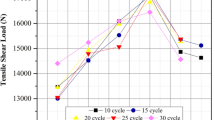Abstract
AHSS grade dissimilar TWIP/martensitic steel joints were produced with resistance spot welding with different welding times and welding currents under 4-kN electrode force. The microstructures were examined with EDS, SEM, and XRD analyses. Fusion zone especially at high heat inputs exhibited considerable amount of shrinkage gaps and high Mn content–induced voids. (Fe, Mn)xC segregation behavior in heat-affected zone (HAZ) of TWIP was coincided. Segregation behavior adversely affected HAZ and limited tensile-shear force bearing capacity. Failure mode change from interfacial failure to nugget pullout failure mode was mainly controlled by the nugget size diameter. Tearing-type failure mode was not observed in all experiments. All nugget pullout separations were failed from the TWIP side due to segregation-induced intergranular gaps. Tensile-shear fracture surfaces were examined and MxC segregation–induced gaps were observed. The weld lobe was determined according to mechanical and geometrical calculations.



















Similar content being viewed by others
Data availability
Not applicable.
References
Bračun D, Polajnar I, Diaci J (2006) Indentation shape parameters as indicators of spot weld quality. Int J Mater Prod Technol 27(3–4):247–257. https://doi.org/10.1504/IJMPT.2006.011275
Cortéz VHL, Valdés FAR, Treviño LT (2009) Weldability of martensitic steel by resistance spot welding a neural network optimization in the automotive industry. Mater Manuf Process 24(12):1412–1417. https://doi.org/10.1080/10426910903343916
Dahmen M, Lindner S, Monfort D, Petring D (2016) Weld metallurgy and mechanical properties of high manganese ultra-high strength steel dissimilar welds. Phys Procedia 83:344–351. https://doi.org/10.1016/j.phpro.2016.08.036
Gutierrez-Urrutia I, Zaefferer S, Raabe D (2010) The effect of grain size and grain orientation on deformation twinning in a Fe-22wt.% Mn-0.6wt.% C TWIP steel. Mater Sci Eng A 527(15):3552–3560. https://doi.org/10.1016/j.msea.2010.02.041
Hayat F, Demir B, Acarer M, Aslanlar S (2010) Adhesive weld bonding of interstitial free steel at spot welding for automotive application. Kov Mater 48(2):137–143. https://doi.org/10.4149/km_2010_2_137
Jong Y-S, Lee Y-K, Kim D-C, Kang M-J, Hwang I-S, Lee W-B (2011) Microstructural evolution and mechanical properties of resistance spot welded ultra high strength steel containing boron. Mater Trans 52(6):1330–1333. https://doi.org/10.2320/matertrans.M2011005
Kang JH, Ingendahl T, Bleck W (2016) A constitutive model for the tensile behaviour of TWIP steels: composition and temperature dependencies. Mater Des 90:340–349. https://doi.org/10.1016/j.matdes.2015.10.126
Kazdal Zeytin H, Ertek Emre H, Kaçar R (2017) Properties of resistance spot-welded TWIP steels. Metals (Basel) 7(1):14. https://doi.org/10.3390/met7010014
Mujica L, Weber S, Pinto H, Thomy C, Vollertsen F (2010) Microstructure and mechanical properties of laser-welded joints of TWIP and TRIP steels. Mater Sci Eng A 527(7–8):2071–2078. https://doi.org/10.1016/j.msea.2009.11.050
Mújica Roncery L, Weber S, Theisen W (2012) Welding of twinning-induced plasticity steels. Scr Mater 66(12):997–1001. https://doi.org/10.1016/j.scriptamat.2011.11.041
Onar V, Aslanlar S (2017) Welding time effect of welding joints in micro alloyed and TRIP 800 steels in resistance spot welding. Acta Phys Pol A 131(3):389–392. https://doi.org/10.12693/APhysPolA.131.389
Papadimitriou I, Efthymiadis P, Kotadia HR, Sohn IR, Sridhar S (2017) Joining TWIP to TWIP and TWIP to aluminium: a comparative study between joining processes, joint properties and mechanical performance. J Manuf Process 30:195–207. https://doi.org/10.1016/j.jmapro.2017.09.012
Pouranvari M, Marashi SPH (2010) Minimum fusion zone size required to ensure pullout failure mode of resistance spot welds during tensile-shear test. Kov Mater 48(3):197–202. https://doi.org/10.4149/km-2010-3-197
Pouranvari M, Sobhani S, Goodarzi F (2018) Resistance spot welding of MS1200 martensitic advanced high strength steel: microstructure-properties relationship. J Manuf Process 31:867–874. https://doi.org/10.1016/j.jmapro.2018.01.009
Pouranvari M, Mousavizadeh SM (2013) Failure mode of M130 martensitic steel resistance-spot welds. Mater Tehnol 47(6):771–776
Razmpoosh MHH, Shamanian M, Esmailzadeh M (2015) The microstructural evolution and mechanical properties of resistance spot welded Fe–31Mn–3Al–3Si TWIP steel. Mater Des 67:571–576. https://doi.org/10.1016/j.matdes.2014.10.090
Sabzi M, Farzam M (2019) Hadfield manganese austenitic steel: a review of manufacturing processes and properties. Mater Res Express 6(10). https://doi.org/10.1088/2053-1591/ab3ee3
Saha DC, Cho Y, Park Y-D (2013) Metallographic and fracture characteristics of resistance spot welded TWIP steels. Sci Technol Weld Join 18(8):711–720. https://doi.org/10.1179/1362171813Y.0000000151
Saha DC, Chang I, Park Y Do. (2014a) Heat-affected zone liquation crack on resistance spot welded TWIP steels. Mater Charact 93:40–51. https://doi.org/10.1016/j.matchar.2014.03.016
Saha DC, Han S, Chin KG, Choi I, Park Y Do. (2012) Weldability evaluation and microstructure analysis of resistance-spot-welded high-Mn steel in automotive application. Steel Res Int 83(4):352–357. https://doi.org/10.1002/srin.201100324
Wan Z, Wang H, Chen N, Wang M, Carlson BE (2017) Characterization of intermetallic compound at the interfaces of Al-steel resistance spot welds. J Mater Process Technol 242:12–23. https://doi.org/10.1016/j.jmatprotec.2016.11.017
Wei ST, Liu RD, Lv D, Lin L, Xu RJ, Guo JY, Wang KQ, Lu XF (2015) Weldability and mechanical properties of similar and dissimilar resistance spot welds of three-layer advanced high strength steels. Sci Technol Weld Join 20(1):20–26. https://doi.org/10.1179/1362171814Y.0000000250
Wolf S, Martin S, Krüger L, Martin U (2014) Constitutive modelling of the rate dependent flow stress of cast high-alloyed metastable austenitic TRIP/TWIP steel. Mater Sci Eng A 594:72–81. https://doi.org/10.1016/j.msea.2013.11.041
Yu J, Shim J, Rhee S (2012) Characteristics of resistance spot welding for 1 GPa grade twin induced plasticity steel. Mater Trans 53(11):2011–2018. https://doi.org/10.2320/matertrans.M2012167
Zhao D, Wang Y, Liang D (2019) Correlating variations in the dynamic power signature to nugget diameter in resistance spot welding using kriging model. Meas J Int Meas Confed 135:6–12. https://doi.org/10.1016/j.measurement.2018.11.025
Acknowledgements
The authors would like to acknowledge Sakarya University and Sakarya University of Applied Sciences for their laboratory use. The authors also thank ASAŞ Aluminium Company for the use of material characterization devices.
Author information
Authors and Affiliations
Contributions
Dr. Fatih ÖZEN was responsible for methodology, experimental works, metallurgical characterizations, conceptualization, and original draft preparation. Prof. Dr. Salim Aslanlar was responsible for conceptualization, methodology, weld lobe determination, review and editing, and supervision.
Corresponding author
Ethics declarations
Ethics approval
Not applicable.
Consent to participate
Not applicable.
Consent for publication
Not applicable.
Competing interests
The authors declare no competing interests.
Additional information
Publisher’s note
Springer Nature remains neutral with regard to jurisdictional claims in published maps and institutional affiliations.
Rights and permissions
About this article
Cite this article
Özen, F., Aslanlar, S. Mechanical and microstructural evaluation of resistance spot welded dissimilar TWIP/martensitic steel joints. Int J Adv Manuf Technol 113, 3473–3489 (2021). https://doi.org/10.1007/s00170-021-06848-3
Received:
Accepted:
Published:
Issue Date:
DOI: https://doi.org/10.1007/s00170-021-06848-3




